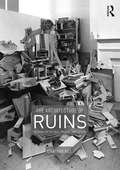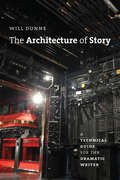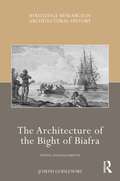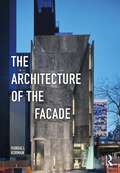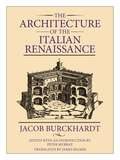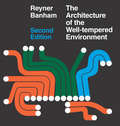- Table View
- List View
Architecture of Resistance: Cultivating Moments of Possibility within the Palestinian/Israeli Conflict (Design Research in Architecture)
by Yara SharifArchitecture of Resistance investigates the relationship between architecture, politics and power, and how these factors interplay in light of the Palestinian/Israeli conflict. It takes Palestine as the key ground of spatial exploration, looking at the spaces between people, boundary lines, documents and maps in a search for the meaning of architecture of resistance. Stemming from the need for an alternative discourse that can nourish the Palestinian spaces of imagination, the author reinterprets the land from a new perspective, by stripping it of the dominant power of lines to expose the hidden dynamic topography born out of everyday Palestine. It applies a hybrid approach of research through design and visual documentary, through text, illustrations, mapping techniques and collages, to capture the absent local narrative as an essential component of spatial investigation.
The Architecture of Ruins: Designs on the Past, Present and Future
by Jonathan HillThe Architecture of Ruins: Designs on the Past, Present and Future identifies an alternative and significant history of architecture from the sixteenth century to the twenty-first century, in which a building is designed, occupied and imagined as a ruin. This design practice conceives a monument and a ruin as creative, interdependent and simultaneous themes within a single building dialectic, addressing temporal and environmental questions in poetic, psychological and practical terms, and stimulating questions of personal and national identity, nature and culture, weather and climate, permanence and impermanence and life and death. Conceiving a building as a dialogue between a monument and a ruin intensifies the already blurred relations between the unfinished and the ruined and envisages the past, the present and the future in a single architecture. Structured around a collection of biographies, this book conceives a monument and a ruin as metaphors for a life and means to negotiate between a self and a society. Emphasising the interconnections between designers and the particular ways in which later architects learned from earlier ones, the chapters investigate an evolving, interdisciplinary design practice to show the relevance of historical understanding to design. Like a history, a design is a reinterpretation of the past that is meaningful to the present. Equally, a design is equivalent to a fiction, convincing users to suspend disbelief. We expect a history or a novel to be written in words, but they can also be delineated in drawing, cast in concrete or seeded in soil. The architect is a ‘physical novelist’ as well as a ‘physical historian’. Like building sites, ruins are full of potential. In revealing not only what is lost, but also what is incomplete, a ruin suggests the future as well as the past. As a stimulus to the imagination, a ruin’s incomplete and broken forms expand architecture’s allegorical and metaphorical capacity, indicating that a building can remain unfinished, literally and in the imagination, focusing attention on the creativity of users as well as architects. Emphasising the symbiotic relations between nature and culture, a building designed, occupied and imagined as a ruin acknowledges the coproduction of multiple authors, whether human, non-human or atmospheric, and is an appropriate model for architecture in an era of increasing climate change.
The Architecture of Ruins: Designs on the Past, Present and Future
by Jonathan HillThe Architecture of Ruins: Designs on the Past, Present and Future identifies an alternative and significant history of architecture from the sixteenth century to the twenty-first century, in which a building is designed, occupied and imagined as a ruin. This design practice conceives a monument and a ruin as creative, interdependent and simultaneous themes within a single building dialectic, addressing temporal and environmental questions in poetic, psychological and practical terms, and stimulating questions of personal and national identity, nature and culture, weather and climate, permanence and impermanence and life and death. Conceiving a building as a dialogue between a monument and a ruin intensifies the already blurred relations between the unfinished and the ruined and envisages the past, the present and the future in a single architecture. Structured around a collection of biographies, this book conceives a monument and a ruin as metaphors for a life and means to negotiate between a self and a society. Emphasising the interconnections between designers and the particular ways in which later architects learned from earlier ones, the chapters investigate an evolving, interdisciplinary design practice to show the relevance of historical understanding to design. Like a history, a design is a reinterpretation of the past that is meaningful to the present. Equally, a design is equivalent to a fiction, convincing users to suspend disbelief. We expect a history or a novel to be written in words, but they can also be delineated in drawing, cast in concrete or seeded in soil. The architect is a ‘physical novelist’ as well as a ‘physical historian’. Like building sites, ruins are full of potential. In revealing not only what is lost, but also what is incomplete, a ruin suggests the future as well as the past. As a stimulus to the imagination, a ruin’s incomplete and broken forms expand architecture’s allegorical and metaphorical capacity, indicating that a building can remain unfinished, literally and in the imagination, focusing attention on the creativity of users as well as architects. Emphasising the symbiotic relations between nature and culture, a building designed, occupied and imagined as a ruin acknowledges the coproduction of multiple authors, whether human, non-human or atmospheric, and is an appropriate model for architecture in an era of increasing climate change.
The Architecture of San Juan de Puerto Rico: Five centuries of urban and architectural experimentation (Routledge Research in Architecture)
by Arleen Pabon-CharnecoAs San Juan nears the 500th anniversary of its founding, Arleen Pabón-Charneco explores the urban and architectural developments that have taken place over the last five centuries, transforming the site from a small Caribbean enclave to a sprawling modern capital. As the oldest European settlement in the United States and second oldest in the Western Hemisphere, San Juan is an example of the experimentation that took place in the American "borderland" from 1519 to 1898, when Spanish sovereignty ended. The author also investigates post-1898 examples to explore how architectural ideas were exported from the mainland United States. Pabón-Charneco covers the varied architectural periods and styles, aesthetic theories and conservation practices of the region and explains how the development of the architectural and urban artifacts reflect the political, cultural, social and religious aspects that metamorphosed a small military garrison into a urban center of international significance.
The Architecture of San Juan de Puerto Rico: Five centuries of urban and architectural experimentation (Routledge Research in Architecture)
by Arleen Pabon-CharnecoAs San Juan nears the 500th anniversary of its founding, Arleen Pabón-Charneco explores the urban and architectural developments that have taken place over the last five centuries, transforming the site from a small Caribbean enclave to a sprawling modern capital. As the oldest European settlement in the United States and second oldest in the Western Hemisphere, San Juan is an example of the experimentation that took place in the American "borderland" from 1519 to 1898, when Spanish sovereignty ended. The author also investigates post-1898 examples to explore how architectural ideas were exported from the mainland United States. Pabón-Charneco covers the varied architectural periods and styles, aesthetic theories and conservation practices of the region and explains how the development of the architectural and urban artifacts reflect the political, cultural, social and religious aspects that metamorphosed a small military garrison into a urban center of international significance.
Architecture of Schools: The New Learning Environments
by Mark DudekThis is the standard design guide on schools architecture, providing vital information on school architecture. Mark Dudek views school building design as a particularly specialised field encompassing ever changing educational theories, the subtle spatial and psychological requirements of growing children and practical issues that are unique to these types of building. He explores the functional requirements of individual spaces, such as classrooms, and shows how their incorporation within a single institution area are a defining characteristic of the effective educational environment. Acoustics, impact damage, the functional differentiation of spaces such as classrooms, music rooms, craft activities and gymnasium, within a single institution are all dealt with. More esoteric factors such as the effects on behaviour of colour, light, surface texture and imagery are considered in addition to the more practical aspects of designing for comfort and health.Chapter 4 comprises 20 case studies which address those issues important in the creation of modern school settings. They are state of the art examples from all parts of the world. These examples include: Pokstown Down Primary, Bournemouth; Haute Vallee School, Jersey; Heinz-Galinski School, Berlin; Anne Frank School, Papendract, Netherlands; Seabird Island School, British Columbia and The Little Village Academy, Chicago.
Architecture of Schools: The New Learning Environments
by Mark DudekThis is the standard design guide on schools architecture, providing vital information on school architecture. Mark Dudek views school building design as a particularly specialised field encompassing ever changing educational theories, the subtle spatial and psychological requirements of growing children and practical issues that are unique to these types of building. He explores the functional requirements of individual spaces, such as classrooms, and shows how their incorporation within a single institution area are a defining characteristic of the effective educational environment. Acoustics, impact damage, the functional differentiation of spaces such as classrooms, music rooms, craft activities and gymnasium, within a single institution are all dealt with. More esoteric factors such as the effects on behaviour of colour, light, surface texture and imagery are considered in addition to the more practical aspects of designing for comfort and health.Chapter 4 comprises 20 case studies which address those issues important in the creation of modern school settings. They are state of the art examples from all parts of the world. These examples include: Pokstown Down Primary, Bournemouth; Haute Vallee School, Jersey; Heinz-Galinski School, Berlin; Anne Frank School, Papendract, Netherlands; Seabird Island School, British Columbia and The Little Village Academy, Chicago.
The architecture of social reform: Housing, tradition, and German Modernism (Studies in Design and Material Culture)
by Isabel RoussetThe architecture of social reform explores the fascinating intellectual origins of modern architecture’s obsession with domesticity. Copiously illustrated, Rousset’s revealing analysis demonstrates how questions over aesthetics, style, urbanization, and technology that gripped the modernist imagination were deeply ingrained in a larger concern to reform society through housing. The increasing demand for new housing in Germany’s rapidly growing cities fostered critical exchanges between a heterogeneous group of actors, including architects, urban theorists, planners, and social scientists, who called for society to be freed from class antagonism through the provision of good, modest, traditionally-minded domestic design. Offering a compelling account of architecture’s ability to act socially, the book provocatively argues that architectural theory underwent its most critical epistemological transformation in relation to the dynamics of modern class politics long before the arrival of the avant-garde.
The architecture of social reform: Housing, tradition, and German Modernism (Studies in Design and Material Culture)
by Isabel RoussetThe architecture of social reform explores the fascinating intellectual origins of modern architecture’s obsession with domesticity. Copiously illustrated, Rousset’s revealing analysis demonstrates how questions over aesthetics, style, urbanization, and technology that gripped the modernist imagination were deeply ingrained in a larger concern to reform society through housing. The increasing demand for new housing in Germany’s rapidly growing cities fostered critical exchanges between a heterogeneous group of actors, including architects, urban theorists, planners, and social scientists, who called for society to be freed from class antagonism through the provision of good, modest, traditionally-minded domestic design. Offering a compelling account of architecture’s ability to act socially, the book provocatively argues that architectural theory underwent its most critical epistemological transformation in relation to the dynamics of modern class politics long before the arrival of the avant-garde.
The Architecture of Steam: Waterworks and the Victorian Sanitary Crisis
by James DouetSteam pumping stations are exceptional buildings, a rousing, eloquent architecture designed by engineers, and an industrial edifice intended to express civic pride. They were invented, perfected and superseded in barely a century during the determined struggle to overcome the historic threat to urban life posed by industrialization. Of the buildings of the industrial period only train stations can compete with waterworks for stylistic bravura, carried over into the cool, tiled interiors and the sparkle and warmth of the cherished steam engine. This first comprehensive account of a remarkable fusion of machinery and structure weaves together architectural fashions, shifting social conditions and engineering inventiveness to show why such care was taken by the communities that commissioned them and by the men who built them, and what makes us take such pleasure in them today. British waterworks heritage is a global reference, for the historical significance of the sites themselves but also for the conservation of the many preserved waterworks, often extending to the reanimation of historic steam engines. No prior knowledge of architecture, sanitation or steam technology is required to enjoy this spirited and richly-illustrated account of a singular British building.
The Architecture of Story: A Technical Guide for the Dramatic Writer (Chicago Guides to Writing, Editing, and Publishing)
by Will DunneWhile successful plays tend to share certain storytelling elements, there is no single blueprint for how a play should be constructed. Instead, seasoned playwrights know how to select the right elements for their needs and organize them in a structure that best supports their particular story. Through his workshops and book The Dramatic Writer’s Companion, Will Dunne has helped thousands of writers develop successful scripts. Now, in The Architecture of Story, he helps writers master the building blocks of dramatic storytelling by analyzing a trio of award-winning contemporary American plays: Doubt: A Parable by John Patrick Shanley, Topdog/Underdog by Suzan-Lori Parks, and The Clean House by Sarah Ruhl. Dismantling the stories and examining key components from a technical perspective enables writers to approach their own work with an informed understanding of dramatic architecture. Each self-contained chapter focuses on one storytelling component, ranging from “Title” and “Main Event” to “Emotional Environment” and “Crisis Decision.” Dunne explores each component in detail, demonstrating how it has been successfully handled in each play and comparing and contrasting techniques. The chapters conclude with questions to help writers evaluate and improve their own scripts. The result is a nonlinear reference guide that lets writers work at their own pace and choose the topics that interest them as they develop new scripts. This flexible, interactive structure is designed to meet the needs of writers at all stages of writing and at all levels of experience.
The Architecture of Story: A Technical Guide for the Dramatic Writer (Chicago Guides to Writing, Editing, and Publishing)
by Will DunneWhile successful plays tend to share certain storytelling elements, there is no single blueprint for how a play should be constructed. Instead, seasoned playwrights know how to select the right elements for their needs and organize them in a structure that best supports their particular story. Through his workshops and book The Dramatic Writer’s Companion, Will Dunne has helped thousands of writers develop successful scripts. Now, in The Architecture of Story, he helps writers master the building blocks of dramatic storytelling by analyzing a trio of award-winning contemporary American plays: Doubt: A Parable by John Patrick Shanley, Topdog/Underdog by Suzan-Lori Parks, and The Clean House by Sarah Ruhl. Dismantling the stories and examining key components from a technical perspective enables writers to approach their own work with an informed understanding of dramatic architecture. Each self-contained chapter focuses on one storytelling component, ranging from “Title” and “Main Event” to “Emotional Environment” and “Crisis Decision.” Dunne explores each component in detail, demonstrating how it has been successfully handled in each play and comparing and contrasting techniques. The chapters conclude with questions to help writers evaluate and improve their own scripts. The result is a nonlinear reference guide that lets writers work at their own pace and choose the topics that interest them as they develop new scripts. This flexible, interactive structure is designed to meet the needs of writers at all stages of writing and at all levels of experience.
The Architecture of Story: A Technical Guide for the Dramatic Writer (Chicago Guides to Writing, Editing, and Publishing)
by Will DunneWhile successful plays tend to share certain storytelling elements, there is no single blueprint for how a play should be constructed. Instead, seasoned playwrights know how to select the right elements for their needs and organize them in a structure that best supports their particular story. Through his workshops and book The Dramatic Writer’s Companion, Will Dunne has helped thousands of writers develop successful scripts. Now, in The Architecture of Story, he helps writers master the building blocks of dramatic storytelling by analyzing a trio of award-winning contemporary American plays: Doubt: A Parable by John Patrick Shanley, Topdog/Underdog by Suzan-Lori Parks, and The Clean House by Sarah Ruhl. Dismantling the stories and examining key components from a technical perspective enables writers to approach their own work with an informed understanding of dramatic architecture. Each self-contained chapter focuses on one storytelling component, ranging from “Title” and “Main Event” to “Emotional Environment” and “Crisis Decision.” Dunne explores each component in detail, demonstrating how it has been successfully handled in each play and comparing and contrasting techniques. The chapters conclude with questions to help writers evaluate and improve their own scripts. The result is a nonlinear reference guide that lets writers work at their own pace and choose the topics that interest them as they develop new scripts. This flexible, interactive structure is designed to meet the needs of writers at all stages of writing and at all levels of experience.
The Architecture of Story: A Technical Guide for the Dramatic Writer (Chicago Guides to Writing, Editing, and Publishing)
by Will DunneWhile successful plays tend to share certain storytelling elements, there is no single blueprint for how a play should be constructed. Instead, seasoned playwrights know how to select the right elements for their needs and organize them in a structure that best supports their particular story. Through his workshops and book The Dramatic Writer’s Companion, Will Dunne has helped thousands of writers develop successful scripts. Now, in The Architecture of Story, he helps writers master the building blocks of dramatic storytelling by analyzing a trio of award-winning contemporary American plays: Doubt: A Parable by John Patrick Shanley, Topdog/Underdog by Suzan-Lori Parks, and The Clean House by Sarah Ruhl. Dismantling the stories and examining key components from a technical perspective enables writers to approach their own work with an informed understanding of dramatic architecture. Each self-contained chapter focuses on one storytelling component, ranging from “Title” and “Main Event” to “Emotional Environment” and “Crisis Decision.” Dunne explores each component in detail, demonstrating how it has been successfully handled in each play and comparing and contrasting techniques. The chapters conclude with questions to help writers evaluate and improve their own scripts. The result is a nonlinear reference guide that lets writers work at their own pace and choose the topics that interest them as they develop new scripts. This flexible, interactive structure is designed to meet the needs of writers at all stages of writing and at all levels of experience.
The Architecture of Story: A Technical Guide for the Dramatic Writer (Chicago Guides to Writing, Editing, and Publishing)
by Will DunneWhile successful plays tend to share certain storytelling elements, there is no single blueprint for how a play should be constructed. Instead, seasoned playwrights know how to select the right elements for their needs and organize them in a structure that best supports their particular story. Through his workshops and book The Dramatic Writer’s Companion, Will Dunne has helped thousands of writers develop successful scripts. Now, in The Architecture of Story, he helps writers master the building blocks of dramatic storytelling by analyzing a trio of award-winning contemporary American plays: Doubt: A Parable by John Patrick Shanley, Topdog/Underdog by Suzan-Lori Parks, and The Clean House by Sarah Ruhl. Dismantling the stories and examining key components from a technical perspective enables writers to approach their own work with an informed understanding of dramatic architecture. Each self-contained chapter focuses on one storytelling component, ranging from “Title” and “Main Event” to “Emotional Environment” and “Crisis Decision.” Dunne explores each component in detail, demonstrating how it has been successfully handled in each play and comparing and contrasting techniques. The chapters conclude with questions to help writers evaluate and improve their own scripts. The result is a nonlinear reference guide that lets writers work at their own pace and choose the topics that interest them as they develop new scripts. This flexible, interactive structure is designed to meet the needs of writers at all stages of writing and at all levels of experience.
The Architecture of Story: A Technical Guide for the Dramatic Writer (Chicago Guides to Writing, Editing, and Publishing)
by Will DunneWhile successful plays tend to share certain storytelling elements, there is no single blueprint for how a play should be constructed. Instead, seasoned playwrights know how to select the right elements for their needs and organize them in a structure that best supports their particular story. Through his workshops and book The Dramatic Writer’s Companion, Will Dunne has helped thousands of writers develop successful scripts. Now, in The Architecture of Story, he helps writers master the building blocks of dramatic storytelling by analyzing a trio of award-winning contemporary American plays: Doubt: A Parable by John Patrick Shanley, Topdog/Underdog by Suzan-Lori Parks, and The Clean House by Sarah Ruhl. Dismantling the stories and examining key components from a technical perspective enables writers to approach their own work with an informed understanding of dramatic architecture. Each self-contained chapter focuses on one storytelling component, ranging from “Title” and “Main Event” to “Emotional Environment” and “Crisis Decision.” Dunne explores each component in detail, demonstrating how it has been successfully handled in each play and comparing and contrasting techniques. The chapters conclude with questions to help writers evaluate and improve their own scripts. The result is a nonlinear reference guide that lets writers work at their own pace and choose the topics that interest them as they develop new scripts. This flexible, interactive structure is designed to meet the needs of writers at all stages of writing and at all levels of experience.
The Architecture of the Bight of Biafra: Spatial Entanglements (Routledge Research in Architectural History)
by Joseph GodlewskiThe Architecture of the Bight of Biafra challenges linear assumptions about agency, progress, and domination in colonial and postcolonial cities, adding an important sub‑Saharan case study to existing scholarship on globalization and modernity.Intersected by small creeks, rivulets, and dotted with mangrove swamps, the Bight of Biafra has a long history of decentralized political arrangements and intricate trading networks predating the emergence of the Atlantic world. While indigenous merchants in the region were active participants in the transatlantic slave trading system, they creatively resisted European settlement and maintained indigenous sovereignty until the middle of the nineteenth century. Since few built artifacts still exist, this study draws from a close reading of written sources—travelers’ accounts, slave traders’ diaries, missionary memoirs, colonial records, and oral histories—as well as contemporary fieldwork to trace transformations in the region’s built environment from the sixteenth century to today. With each chapter focusing on a particular spatial paradigm in this dynamic process, this book uncovers the manifold and inventive ways in which actors strategically adapted the built environment to adjust to changing cultural and economic circumstances. In parallel, it highlights the ways that these spaces were rhetorically constructed and exploited by foreign observers and local agents. Enmeshed in the history of slavery, colonialism, and the modern construction of race, the spatial dynamics of the Biafran region have not been geographically delimited. The central thesis of this volume is that these spaces of entanglement have been productive sites of Black identity formation involving competing and overlapping interests, occupying multiple positions and temporalities, and ensnaring real, imagined, and sometimes contradictory aims.This book will be of interest to researchers and students of architecture, architectural history, urban geography, African studies, and Atlantic studies.
The Architecture of the Bight of Biafra: Spatial Entanglements (Routledge Research in Architectural History)
by Joseph GodlewskiThe Architecture of the Bight of Biafra challenges linear assumptions about agency, progress, and domination in colonial and postcolonial cities, adding an important sub‑Saharan case study to existing scholarship on globalization and modernity.Intersected by small creeks, rivulets, and dotted with mangrove swamps, the Bight of Biafra has a long history of decentralized political arrangements and intricate trading networks predating the emergence of the Atlantic world. While indigenous merchants in the region were active participants in the transatlantic slave trading system, they creatively resisted European settlement and maintained indigenous sovereignty until the middle of the nineteenth century. Since few built artifacts still exist, this study draws from a close reading of written sources—travelers’ accounts, slave traders’ diaries, missionary memoirs, colonial records, and oral histories—as well as contemporary fieldwork to trace transformations in the region’s built environment from the sixteenth century to today. With each chapter focusing on a particular spatial paradigm in this dynamic process, this book uncovers the manifold and inventive ways in which actors strategically adapted the built environment to adjust to changing cultural and economic circumstances. In parallel, it highlights the ways that these spaces were rhetorically constructed and exploited by foreign observers and local agents. Enmeshed in the history of slavery, colonialism, and the modern construction of race, the spatial dynamics of the Biafran region have not been geographically delimited. The central thesis of this volume is that these spaces of entanglement have been productive sites of Black identity formation involving competing and overlapping interests, occupying multiple positions and temporalities, and ensnaring real, imagined, and sometimes contradictory aims.This book will be of interest to researchers and students of architecture, architectural history, urban geography, African studies, and Atlantic studies.
The Architecture of the Facade
by Randall KormanThe Architecture of the Facade provides a comprehensive study of the facade as both a physical and cultural artifact, highlighting its significance as a critical component of the civic realm and arguing for the restoration of the art of the facade as both a subject of study within academia and an aspiration within the profession at large. As the principal surface of mediation, contextualization, and representation, the facade carries the lion’s share of responsibility for containing the internal environment and confronting the outer world. And yet, in recent decades, the very question of what exactly a facade is has been raised by the dramatic changes in building technology, advances of parametric design, and the ubiquity of autonomous buildings. The Architecture of the Facade addresses these and other related issues. The book is organized into 12 chapters, with each chapter focusing on a particular aspect of the phenomenon of the facade such as those of wall, the frame, transparency, and the role of the facade in civic space. Korman also discusses proportional systems, the language of composition, the role of precedent, the importance of context, and much more. Over 350 photos and diagrams provide readers with a variety of examples of artful facades throughout history. Online teaching resources that accompany this book include a course syllabus, a glossary, and a Pinterest tack board of facades. This book will be of great interest to students in architecture studios as well as instructors and professional architects interested in facade design.
The Architecture of the Facade
by Randall KormanThe Architecture of the Facade provides a comprehensive study of the facade as both a physical and cultural artifact, highlighting its significance as a critical component of the civic realm and arguing for the restoration of the art of the facade as both a subject of study within academia and an aspiration within the profession at large. As the principal surface of mediation, contextualization, and representation, the facade carries the lion’s share of responsibility for containing the internal environment and confronting the outer world. And yet, in recent decades, the very question of what exactly a facade is has been raised by the dramatic changes in building technology, advances of parametric design, and the ubiquity of autonomous buildings. The Architecture of the Facade addresses these and other related issues. The book is organized into 12 chapters, with each chapter focusing on a particular aspect of the phenomenon of the facade such as those of wall, the frame, transparency, and the role of the facade in civic space. Korman also discusses proportional systems, the language of composition, the role of precedent, the importance of context, and much more. Over 350 photos and diagrams provide readers with a variety of examples of artful facades throughout history. Online teaching resources that accompany this book include a course syllabus, a glossary, and a Pinterest tack board of facades. This book will be of great interest to students in architecture studios as well as instructors and professional architects interested in facade design.
The Architecture of the Illusive Distance
by Amir H. AmeriFocusing on three secular institutional building types: libraries, museums, and cinemas, this book explores the intricate interplay between culture and architecture. It explores the cultural imperatives which have seen to the formation of these institutions, the development of their architecture, and their transformation over time. The relationship between culture and architecture is often perceived as a monologic relationship. Architecture is seen to embody, represent and/or reflect the values, the beliefs, and the aesthetic ideals of a culture. Ameri argues that this is at best a partial and restrictive view, and that if architecture is a cultural statement, it is a performative one. It does not merely represent culture, but constructs, reifies, and imposes culture as the unalterable shape of reality. Whereas the concept and the study of cultural performatives have had an important critical impact on the humanities, architecture as a cultural performative has not received the necessary scholarly attention and, in part, this book aims to fill this gap. Whereas building-type studies have been largely restricted to elucidating how best to design building-types based on historic and contemporary precedents, studies in the humanities that analytically and critically engage the secular institutions and their history as cultural performatives, typically cast a blind or perfunctory glance at the performative complicity of their architecture. This book aims to address the omissions in both these approaches. The library, the museum, and the movie-theater have been selected for close critical study because, this book argues, each has been instituted to house, ’domesticate,’ and restrain a specific form of representation. The aim has been to protect and promulgate the metaphysics of presence as Jacques Derrida expounds the concept. This book proposes that it is against the dangers of unconstrained cohabitation of reality and representation that the library, the m
The Architecture of the Illusive Distance
by Amir H. AmeriFocusing on three secular institutional building types: libraries, museums, and cinemas, this book explores the intricate interplay between culture and architecture. It explores the cultural imperatives which have seen to the formation of these institutions, the development of their architecture, and their transformation over time. The relationship between culture and architecture is often perceived as a monologic relationship. Architecture is seen to embody, represent and/or reflect the values, the beliefs, and the aesthetic ideals of a culture. Ameri argues that this is at best a partial and restrictive view, and that if architecture is a cultural statement, it is a performative one. It does not merely represent culture, but constructs, reifies, and imposes culture as the unalterable shape of reality. Whereas the concept and the study of cultural performatives have had an important critical impact on the humanities, architecture as a cultural performative has not received the necessary scholarly attention and, in part, this book aims to fill this gap. Whereas building-type studies have been largely restricted to elucidating how best to design building-types based on historic and contemporary precedents, studies in the humanities that analytically and critically engage the secular institutions and their history as cultural performatives, typically cast a blind or perfunctory glance at the performative complicity of their architecture. This book aims to address the omissions in both these approaches. The library, the museum, and the movie-theater have been selected for close critical study because, this book argues, each has been instituted to house, ’domesticate,’ and restrain a specific form of representation. The aim has been to protect and promulgate the metaphysics of presence as Jacques Derrida expounds the concept. This book proposes that it is against the dangers of unconstrained cohabitation of reality and representation that the library, the m
The Architecture of the Italian Renaissance (World Of Art Ser.)
by Jacob Burckhardt"There may not be any book on architecture so delightful to dip into; one wishes there were a pocket edition to take on an Italian vacation—not only for its information and vision but for such pleasant reminders as that the citizens of Treviso carried Tullio Lombardo's friezes through the town in triumph before they were attached to a building."—D. J. R. Bruckner, New York Times Book Review
Architecture of the Well-Tempered Environment
by Reyner BanhamReyner Banham was a pioneer in arguing that technology, human needs, and environmental concerns must be considered an integral part of architecture. No historian before him had so systematically explored the impact of environmental engineering on the design of buildings and on the minds of architects. In this revision of his classic work, Banham has added considerable new material on the use of energy, particularly solar energy, in human environments. Included in the new material are discussions of Indian pueblos and solar architecture, the Centre Pompidou and other high-tech buildings, and the environmental wisdom of many current architectural vernaculars.
Architecture of the Well-Tempered Environment
by Reyner BanhamReyner Banham was a pioneer in arguing that technology, human needs, and environmental concerns must be considered an integral part of architecture. No historian before him had so systematically explored the impact of environmental engineering on the design of buildings and on the minds of architects. In this revision of his classic work, Banham has added considerable new material on the use of energy, particularly solar energy, in human environments. Included in the new material are discussions of Indian pueblos and solar architecture, the Centre Pompidou and other high-tech buildings, and the environmental wisdom of many current architectural vernaculars.

